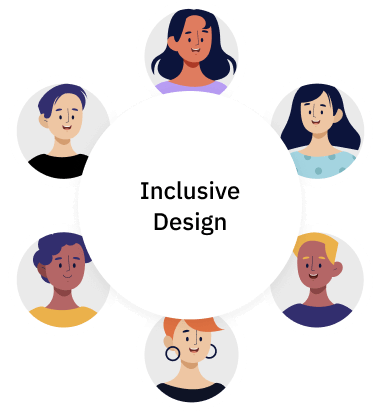Inclusivity and Accessibility: Differences in Experience Design
February 15, 2023 | Read Time : 3 mins
Table of Contents
The goal of accessibility is to make things useful for everyone. On the other side, Inclusive Design takes user diversity into account.
The definition of Inclusive and Accessible Design
Let’s start by clarifying that there are Accessible and Inclusive Designs everywhere. Not just in designing buildings and producing various things but also in technology, websites, platforms, and apps.
They are beliefs and behaviours that, when implemented, make many people’s lives simpler. Continue reading to learn what they mean:
Accessible Design
The term “Accessible Design” refers to meeting the demands of people who are disabled so that they can use a product just as efficiently as the rest of the population.
The Web Accessibility Initiative was founded in 1997 to assist in making the internet more accessible to individuals with disabilities. They contend that minor UI improvements are often sufficient to improve accessibility.
Inclusive Design
While Accessible Design focuses on personalising products for specific people with disabilities, Inclusive Design is a broader spectrum that focuses on developing for everyone. It considers the environment, situational limitations, individual perspectives, and anything else impeding ability.
Inclusive Design aspires to create a flexible environment that can adapt to everyone’s needs without finding a workaround.

What is the difference between Inclusive And Accessible Design?
Inclusive Design is for everyone
The Accessible Design considers the unique requirements of chronically impaired persons, whereas inclusion considers permanent, temporary, and situational impairments.
While seeking Inclusive Design, the requirements of all types of temporarily disabled persons are also considered, resulting in a universal design.
Accessible Design focuses on the finished product, whereas Inclusive Design is an approach
The main goal of Accessible Design is to make it easy for people with disabilities to use. It doesn’t consider how they could alter their plans in the future or even how it would impact somebody who is not disabled.
An Inclusive Design technique drives designers to consider ways to make a product simpler for everyone. It is not motivated by an immediate result and considers situational handicaps that may make it more difficult for humans to use technology.
Inclusive Design does not have legal standards, but the Accessible Design does
To make a product accessible to those with disabilities, several criteria and principles must be followed. At the same time, the Inclusive Design focuses on innovation and creativity to make designs more user-friendly for everyone.
How do Inclusive and Exclusive Design work?
Although they appear separate on paper, many of their important characteristics are interconnected. Let’s see how the two may connect in further detail:
- Accessible Design is a key part of Inclusive Design: Accessible Design is an important aspect of Inclusive Design as a whole. Making the website keyboard accessible can benefit both people who are blind and those who recently broke their mouse, so consider this. Alt-texting your photos is another option. It benefits everyone, including those with poor connectivity and the visually handicapped. Additionally, Inclusive Design may result in Accessible Design.
- They both pursue the same objective: The result of both Inclusive and Accessible Design is to increase the usefulness of the final product. Both ideologies aspire to help those who are disabled, whether such disabilities be temporary or permanent. Additionally, both methodologies take inspiration from how individuals solve certain challenges; as a result, they reinforce each other.
The UI UX revolution’s next phase necessitates that all goods and services be available to everyone and serve all use cases. After all, 6% of people worldwide have hearing loss, and 3.2% have a visual impairment. Irrespective of what you’re doing, Inclusive Design is essential. Focusing on Inclusive Design and Accessibility often results in flawless UI and UX design.






